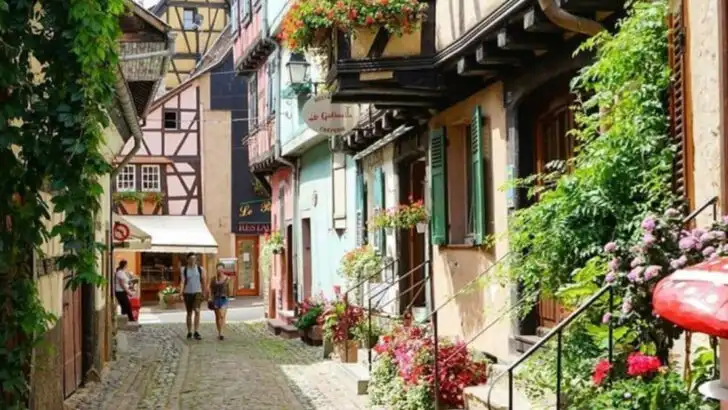The best places in Europe? They’re not in guidebooks. They’re tucked between mountains, hidden behind vineyards, or perched on cliffs where time forgot to keep moving. No tour buses. No souvenir shops. Just cobblestone streets, crooked houses, and food that tastes like a secret. These villages don’t try to impress you — and that’s exactly why they do. You’ll stumble into a bakery run by someone’s grandma. You’ll hear church bells instead of traffic. You’ll wonder why no one ever told you this place existed. This isn’t a list of “pretty spots.” It’s a passport to the kinds of towns that steal your heart while you’re still figuring out how to pronounce their name. Ready to wander where the crowds haven’t found yet? Let’s go find the magic.
Eguisheim, France – Window Boxes and Wisteria Trails
Eguisheim is an enchanting Alsatian village that wraps its narrow, cobbled streets around captivating half-timbered houses dressed in bright geraniums and trailing wisteria vines. Walking through the village is like stepping into a living garden, where locals refresh flower boxes each season, creating a symphony of colors from spring to fall. The vibrant floral displays are not just for show; they reflect the community’s deep love for gardening and nature. This dedication to floral beauty has earned Eguisheim numerous accolades and a reputation as one of France’s most picturesque villages.
Giethoorn, Netherlands – Canals Framed by Cottage Gardens
Known as the ‘Dutch Venice,’ Giethoorn is a serene village where footpaths and waterways are lined with tidy cottage gardens and wildflowers. The village exudes a timeless charm as many homes feature thatched roofs surrounded by lush hydrangeas, daisies, and neatly clipped hedges. As you glide along the canals in a whisper-quiet boat, you’ll be enveloped by the beauty of nature and the tranquility that defines Giethoorn. The gardens are not only a visual delight but also reflect the village’s harmonious relationship with water and land.
Castelmezzano, Italy – Rocky Hillside Herbs and Olive Trees
Perched in the rugged Lucanian Dolomites, Castelmezzano is a hidden gem where nature and tradition coexist. The village is adorned with terraced olive groves, fig trees, and fragrant thyme growing between the ancient stone walls. Families here continue the age-old practice of cultivating herbs in pots along the stone steps leading to their homes. This integration of plant life not only sustains the community but also enhances its rustic beauty. The village’s dramatic landscape and aromatic gardens create a captivating atmosphere that lingers in the memory.
Hallstatt, Austria – Lakeside Planters and Alpine Flowers
Nestled beside a serene lake, Hallstatt is a postcard-perfect village renowned for its traditional Austrian homes with steep balconies overflowing with vibrant red and pink flowers. The community’s devotion to floral beauty is evident in the abundance of edible alpine plants like chives and strawberries interspersed among decorative blooms. This harmonious blend of ornamental and edible plants adds a unique flavor to the village’s aesthetic. The breathtaking views, combined with the floral artistry, make Hallstatt an unforgettable destination where nature and culture unite.
Júzcar, Spain – Blue Walls, Blooming Bougainvillea
Júzcar, once a traditional white village, transformed into a vibrant blue wonderland for a movie promotion. This unique backdrop, now complemented by contrasting bursts of pink bougainvillea and green succulents, has given Júzcar a distinct identity. The community has embraced this transformation with coordinated plantings that either match or strikingly contrast the blue walls. This playful and colorful environment invites visitors to explore its charming streets and lush gardens. Júzcar is a testament to how color and creativity can redefine a village’s character and allure.
Albarracín, Spain
Albarracín will transport you back in time with its medieval allure. Nestled high in the mountains of Spain’s Aragon region, the village is a labyrinth of narrow cobblestone streets and pink-hued buildings. The ancient walls and towers add an air of mystery and history, making it a photographer’s paradise.
The surrounding Sierra de Albarracín offers breathtaking views and a chance to connect with nature. As you wander through this historic gem, the aroma of local Spanish cuisine wafts through the air, inviting you to sample authentic flavors. Albarracín is not just a visit; it’s an experience that lingers.
Did you know? The village was almost left in ruins after the Spanish Civil War, but careful restoration has returned it to its former glory. A journey here is a step back into a time of knights and castles.
Bled, Slovenia – Lakeside Parks and Alpine Trees
Bled, famed for its island church, offers much more with its lush lakeside parks and alpine trees. The air is filled with the refreshing scent of pine as you explore flowerbeds and paths lined with majestic chestnut and linden trees. The village’s natural beauty is complemented by a walking path bordered by native flowers, encircling the entire lake. This picturesque setting invites leisurely strolls and quiet moments of reflection. Bled’s enchanting landscapes and rich botanical heritage make it a haven for nature lovers seeking tranquility.
Reine, Norway – Arctic Wildflowers and Seaside Mosses
Reine, a picturesque fishing village in Norway’s Lofoten Islands, captivates with its colorful houses set against wild, rugged slopes. In summer, these slopes burst into a vibrant tapestry of tiny alpine flowers, while mosses and lichens add soft greens and silver hues year-round. Even in chilly months, the landscape remains a stunning display of natural beauty. This remote village, with its unique Arctic flora, offers an unforgettable experience for those seeking solitude and the raw beauty of Norway’s northern landscapes.
Zalipie, Poland – Painted Flowers and Real Petals
In Zalipie, art and nature meld seamlessly as flowers are painted on homes, barns, and fences while real zinnias, marigolds, and sunflowers bloom outside. This village’s painted motifs not only beautify the surroundings but also reflect each family’s gardening pride. The tradition of floral painting started over a century ago, evolving into an iconic symbol of Zalipie’s cultural identity. The vibrant combination of painted and live flowers creates a whimsical atmosphere, inviting visitors to explore the artistic heritage and horticultural charm of this unique village.
Oia, Greece – Succulents and Sea Breezes
Oia, a charming village on Santorini, captivates with its iconic whitewashed walls and bright blue domes. The steps are a delightful sight, lined with hardy succulents like aloe and cactus, alongside vibrant pots of geraniums. These plants are chosen for their ability to thrive with minimal water, adding bursts of color to the island’s cliffs. The gentle sea breezes enhance the sensory experience, making Oia a picturesque spot where natural beauty meets architectural elegance. Visitors are drawn to its serene landscapes and captivating botanical displays.
Ronda, Spain – Hanging Plants and Canyon Gardens
Ronda, dramatically set atop a deep gorge, mesmerizes with its narrow alleys featuring hanging pots and stone courtyards filled with lemon trees and trailing vines. The iconic bridge offers views of hidden terraces carved into the cliff, where citrus and ivy create lush garden retreats. This blend of dramatic vistas and intimate garden spaces offers a unique exploration of the village’s historical allure. Ronda’s gardens, suspended in mid-air, are a testament to human ingenuity and the harmonious integration of nature and architecture.
Grimentz, Switzerland – Balconies Full of Scarlet Geraniums
Grimentz, an alpine Swiss village, is renowned for its tradition of adorning wooden balconies with scarlet geraniums. These vibrant flowers contrast beautifully with the snowy mountain backdrop, creating a striking visual harmony. The practice of nurturing these geraniums is a cherished tradition, often passed down through generations as cuttings. This dedication to floral beauty not only enhances the village’s aesthetics but also strengthens community bonds. Grimentz’s picturesque charm and commitment to preserving its horticultural heritage make it a captivating destination in the heart of the Alps.
Piódão, Portugal – Slate Paths and Wild Fennel
Nestled in the Serra do Açor mountains, Piódão enchants with its slate-built architecture and terraced hillsides dotted with olive trees, wild fennel, and heather. The village’s unique layout includes winding slate paths that invite exploration and discovery. Residents often dry herbs and display them near doorways, blending beauty with practicality. This integration of nature into daily life creates a harmonious environment that reflects Piódão’s dedication to preserving its cultural and ecological heritage. Visitors are drawn to its rustic charm and the peaceful rhythm of village life.
Crovie, Scotland – Tiny Yards, Wind-Tolerant Flowers
Crovie, a quaint Scottish village with no cars and just one narrow lane, offers a unique glimpse into traditional coastal life. The homes are huddled closely together, each boasting a small yard filled with hardy blooms like lupines and thrift. These wind-tolerant plants endure the salty air from the North Sea, creating vibrant pockets of color amidst the rugged landscape. The challenges of gardening in such conditions are met with creativity and resilience, adding to Crovie’s distinctive charm and allure, making it a must-visit for nature enthusiasts.
San Gimignano, Italy – Olive Orchards and Courtyard Vines
San Gimignano, a medieval hill town, is surrounded by picturesque olive orchards and vineyards. Within its ancient stone walls, you’ll find cozy courtyards filled with grapevines and climbing roses. These verdant spaces offer a tranquil retreat from the bustling streets and provide a glimpse into the town’s rich agricultural heritage. Some ancient walls even support espaliered fruit trees, still producing small harvests. The combination of historical architecture and lush plant life creates a captivating ambiance that transports visitors to a bygone era of Italian splendor.
Bibury, England – Cottages and Riverbank Meadows
Bibury, often hailed as one of the prettiest villages in the Cotswolds, enchants with its flower-lined walkways and charming cottages. The village’s natural beauty is enhanced by the presence of foxgloves and old English roses, creating a quintessentially English scene. Along the River Coln, wild buttercups and purple loosestrife bloom naturally in early summer, adding to the area’s idyllic charm. This harmonious blend of cultivated gardens and wild meadows makes Bibury a picturesque retreat, capturing the essence of rural England and the timeless allure of the Cotswolds.
Eze, France – Vertical Gardens Above the Riviera
Eze, a stone village perched above the Mediterranean, captivates visitors with its vertical gardens. The Jardin Exotique at the village’s summit features terraced beds carved into the rock, filled with succulents, agave, sedum, and low-growing herbs. These gardens offer sweeping views of the sea, blending natural beauty with horticultural artistry. The use of drought-resistant plants reflects the village’s adaptation to its arid environment, enhancing its unique charm. Eze’s breathtaking vistas and verdant terraces invite exploration, offering a serene escape from the bustling Riviera below.
Monemvasia, Greece – Ancient Walls and Seaside Aloe
Monemvasia, built on a rocky island, is a walled village where nature and history converge. Within its ancient walls, courtyards are filled with rosemary, aloe, and citrus trees, creating a lush oasis amidst the rugged landscape. The thick stone walls trap heat, providing a sheltered environment for these plants to thrive despite the ocean’s influence. Monemvasia’s unique combination of historical architecture and vibrant plant life offers a captivating experience for visitors, blending the mystique of ancient Greece with the enduring beauty of the natural world.

